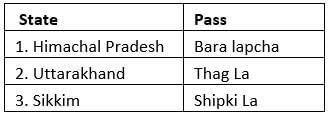टेस्ट: भारत का भौतिक विज्ञान विभाग - UPSC MCQ
15 Questions MCQ Test - टेस्ट: भारत का भौतिक विज्ञान विभाग
हिमालय से संबंधित निम्नलिखित कथनों पर विचार करें:
(i) वे पुराने गुना पहाड़ हैं।
(ii) ये पश्चिम से पूर्व दिशा की ओर चलते हैं
ऊपर दिए गए कथनों में से कौन सा सही है / हैं?
With reference to the Himalayas, consider the following statements:
(i) They are old Guna mountains.
(ii) They move from west to east
Which of the above statements is/are correct?
सिंधु नदी किस सीमा से निकलती है?
From which border does the Indus river originate?
| 1 Crore+ students have signed up on EduRev. Have you? Download the App |
निम्नलिखित पहाड़ियों पर विचार करें:
(i) गारो हिल्स।
(ii) जयंतिया पहाड़ियाँ।
(iii) खासी पहाड़ियाँ।
नीचे दिए गए विकल्प में से कौन पश्चिम से पूर्व की ओर ऊपर की पहाड़ियों की व्यवस्था के संबंध में सही है?
Consider the following hills:
(i) Garo Hills.
(ii) Jaintia Hills.
(iii) Khasi Hills.
Which of the following options is correct with respect to the arrangement of hills from west to east?
निम्नलिखित कथनों पर विचार करें:
(i) नागा हिल्स की सब से ऊँची चोटी सारमाती है।
(ii) मिजो पहाड़ियों में नीला पहाड़ सबसे ऊँचा है
ऊपर दिए गए कथनों में से कौन सा सही है / हैं?
Consider the following statements:
(i) The highest peak of the Naga Hills is Saramati.
(ii) Nila Pahar is the highest among the Mizo hills
Which of the above statements is/are correct?
हिमालय के बारे में, निम्नलिखित में से कौन सा कथन सत्य है?
(i) इनकी चौड़ाई कश्मीर में 400 किलोमीटर से लेकर अरुणाचल प्रदेश में 150 किलोमीटर तक है।
(ii) वे अल्पाइन पृथ्वी आंदोलन के तहत तृतीयक युग के दौरान आए हैं।
(iii) पश्चिमी अर्धांश की तुलना में पूर्वी अर्धांश में ऊँचाई भिन्नताएँ अधिक हैं।
नीचे दिए गए कोड का उपयोग करके सही उत्तर चुनें:
Which of the following statements are true about the Himalayas?
(i) Their width ranges from 400 km in Kashmir to 150 km in Arunachal Pradesh.
(ii) They have come under the alpine earth movement during the Tertiary era.
(iii) The altitude variations are greater in the eastern half than in the western half.
Select the correct answer using the codes given below :
निम्नलिखित जोड़े पर विचार करें:

ऊपर दी गई कौन सी जोड़ी सही है?
निम्न हिमालय के बारे में, निम्नलिखित में से कौन सा कथन सही है?
(i) ये रेंज मेटामॉर्फिक चट्टानों से बनी हैं।
(ii) शिमला, मसूरी, नैनीताल, रानीखेत इसमें खूबसूरत हिल स्टेशन हैं।
(iii) पीर पंजाल कम हिमालय की महत्वपूर्ण श्रेणी है।
ऊपर दिए गए कथनों में से कौन सा सही है / हैं?
Which of the following statements about the Lower Himalayas is correct?
(i) These ranges are made up of metamorphic rocks.
(ii) Shimla, Mussoorie, Nainital, Ranikhet are beautiful hill stations in it.
(iii) Pir Panjal is an important range of Lesser Himalayas.
Which of the above statements is/are correct?
निम्नलिखित मार्ग पर विचार करें:
उच्च बर्फ से ढँकी चोटियों, गहरी घाटियों, इंटरलॉक्ड स्पर्स और हाई माउंटेन पासों द्वारा विशेषता। करेवा मिट्टी जो केसर और अन्य सूखे फलों की खेती के लिए प्रसिद्ध है, यहाँ पाई जाती है। इस क्षेत्र में प्रमुख रेंज में काराकोरम, लद्दाख, पीर पंजाल, ज़स्कर और ढोला धार हैं।
उपरोक्त मार्ग में निम्नलिखित में से किस क्षेत्र का वर्णन किया गया है?
Consider the following route:
Characterized by high snow-capped peaks, deep valleys, interlocked spurs and high mountain passes. Kareva soil which is famous for the cultivation of saffron and other dry fruits is found here. The major ranges in this region are Karakoram, Ladakh, Pir Panjal, Zaskar and Dhola Dhar.
Which of the following areas is described in the above passage?
निम्नलिखित में से किस क्षेत्र में पिंडारी, गंगोत्री और मिलम ग्लेशियर पाए जाते हैं?
In which of the following regions Pindari, Gangotri, and Milam glaciers are found?
निम्नलिखित में से किस क्षेत्र में माउंट। एवरेस्ट, कंचनजंगा, मकालू, धौलागिरी, पर्वत पाए जाते हैं?
In which of the following regions Mt. Everest, Kanchenjunga, Makalu, Dhaulagiri, mountains are found in?
निम्नलिखित में से किसे अक्सर बर्फ की नदी कहा जाता है?
Which of the following is often called the river of ice?
निम्नलिखित जोड़े पर विचार करें:

ऊपर दी गई कौन सी जोड़ी गलत है?
निम्नलिखित कथनों पर विचार करें:
(i) पश्चिमी हिमालय का विस्तार काली नदी के पश्चिम तक है जबकि पूर्वी हिमालय का विस्तार काली से ब्रह्मपुत्र नदी तक है।
(ii) पूर्वी हिमालय की तुलना में पश्चिमी हिमालय में जैव विविधता कम है।
(iii) पूर्वी हिमालय की तुलना में पश्चिमी हिमालय में ऊंचाई अधिक है।
उपरोक्त में से कौन सा कथन पूर्वी हिमालय की पश्चिमी हिमालय की तुलना के बारे में सही है / हैं?
Consider the following statements:
(i) The Western Himalayas extend to the west of the Kali River while the Eastern Himalayas extend from Kali to the Brahmaputra River.
(ii) Biodiversity is less in the Western Himalayas as compared to the Eastern Himalayas.
(iii) The Western Himalayas have higher elevation than the Eastern Himalayas.
Which of the above statement(s) is/are correct about the comparison of the Eastern Himalayas with the Western Himalayas?
निम्नलिखित कथनों पर विचार करें
(i) उत्तरी ढलान की तुलना में दक्षिणी ढलान में अधिक वर्षा होती है।
(ii) दक्षिणी ढलान मोटी वनस्पति से आच्छादित हैं जबकि उत्तरी ढलान आमतौर पर बंजर हैं।
उपरोक्त बयानों में से कौन सा सही है / उत्तरी ढलान की तुलना हिमालय की दक्षिणी ढलानों से की जाती है?
Consider the following statements
(i) The southern slope receives more rainfall than the northern slope.
(ii) The southern slopes are covered with thick vegetation while the northern slopes are generally barren.
Which of the above statements is/are correct as compared to the northern slopes with the southern slopes of the Himalayas?
निम्नलिखित में से कौन सा मार्ग मुंबई को नासिक से जोड़ता है?
Which of the following route connects Mumbai with Nashik?

















